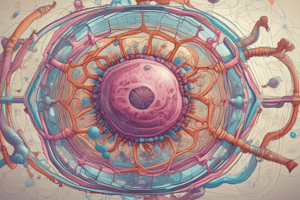Podcast
Questions and Answers
In which type of solution would a cell experience water moving out of it, leading to cell shrinkage?
In which type of solution would a cell experience water moving out of it, leading to cell shrinkage?
- Hypertonic solution (correct)
- Isotonic solution
- Neutral solution
- Hypotonic solution
What type of transport requires energy to move substances against their concentration gradient?
What type of transport requires energy to move substances against their concentration gradient?
- Facilitated diffusion
- Passive transport
- Osmosis
- Active transport (correct)
Which type of transport protein is primarily involved in the movement of ions across membranes?
Which type of transport protein is primarily involved in the movement of ions across membranes?
- Receptor proteins
- Structural proteins
- Carrier proteins
- Channel proteins (correct)
In a hypotonic solution, what would happen to a cell?
In a hypotonic solution, what would happen to a cell?
What distinguishes carrier proteins from pump proteins in membrane transport?
What distinguishes carrier proteins from pump proteins in membrane transport?
Study Notes
Solution Tonicity
- Hypertonic Solutions: Higher concentration of solute compared to water; cells in this environment lose water and may undergo crenation (shrinking).
- Hypotonic Solutions: Lower concentration of solute compared to water; cells gain water, potentially leading to swelling or lysis (bursting).
- Isotonic Solutions: Equal concentrations of solute and water inside and outside of cells; maintains cell shape and prevents net movement of water.
Water Movement Predictions
- In hypertonic environments, water moves out of the cell, causing cells to shrink.
- In hypotonic environments, water moves into the cell, causing cells to swell.
- In isotonic environments, there is no net movement of water, maintaining cell volume and stability.
Energy Requirement for Transport
- Passive Transport: No energy required; substances move along their concentration gradient (from high to low concentration).
- Active Transport: Requires energy (usually ATP) to move substances against their concentration gradient (from low to high concentration).
Transport Proteins and Types
- Transport Proteins: Required for moving substances across membrane barriers, especially for polar or large molecules that cannot freely diffuse.
- Carrier Proteins: Bind to specific substances and undergo conformational changes to shuttle the substance across the membrane.
- Channel Proteins: Create passages that allow specific ions or molecules to flow through the membrane without binding; they are often gated and can open/close in response to signals.
- Pump Proteins: Active transport mechanisms that use energy to move substrates against their gradient, such as the sodium-potassium pump, which is crucial for maintaining cellular homeostasis.
Studying That Suits You
Use AI to generate personalized quizzes and flashcards to suit your learning preferences.
Description
This quiz focuses on understanding the properties of hypertonic, hypotonic, and isotonic solutions and their effects on cell water movement. It also covers the energy requirements for substance transport across membranes and the roles of various transport proteins, including carriers, channels, and pumps.



